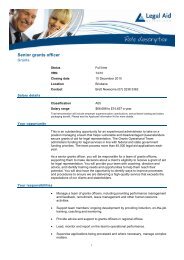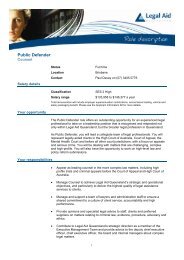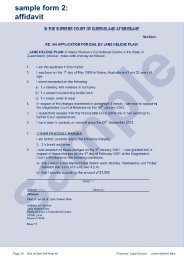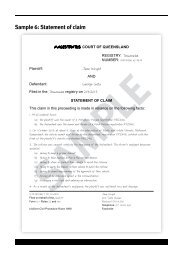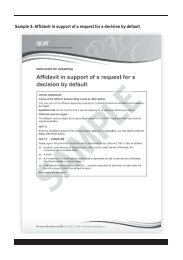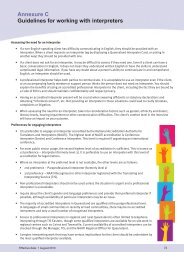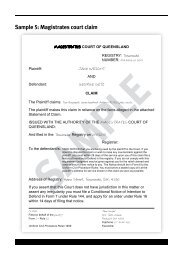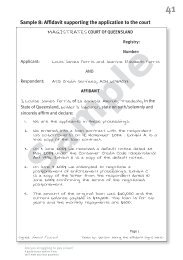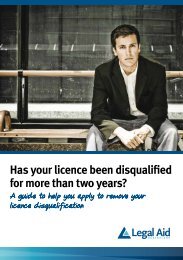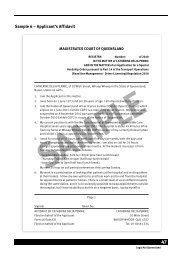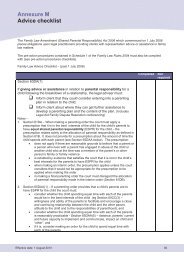Complete issue - Legal Aid Queensland - Queensland Government
Complete issue - Legal Aid Queensland - Queensland Government
Complete issue - Legal Aid Queensland - Queensland Government
- No tags were found...
You also want an ePaper? Increase the reach of your titles
YUMPU automatically turns print PDFs into web optimized ePapers that Google loves.
Disadvantaged borrowers needinterest rate cap protectionVictoria and New South Wales have laws which prevent lenders from charging interest rates above 48percent. But <strong>Queensland</strong> does not offer this protection to vulnerable consumers. <strong>Legal</strong> <strong>Aid</strong> consumerprotection unit solicitors Catherine Uhr and Loretta Kreet make the case for a cap in <strong>Queensland</strong>.TO most people, the idea of the government putting acap on interest rates sounds like fiction rather than fact.The concept goes against our understanding of howinterest rates are set.Anyone with a mortgage would know interest ratesgo up and down based on a range of economic factors,with the Reserve Bank making the decision about howmuch interest we pay.And while that’s all true, many people are not awarethat lenders – banks, building society’s and mortgageproviders – set their own interest rates.Because of competition, most banks and mainstreamlenders set their interest rates at a point slightly abovethe Reserve Bank’s cash rate.But for lenders who don’t have a lot of competitionand aim their services at consumers who can’t borrowmoney from the big banks, the sky seems to be the limitwhen it comes to setting interest rates.Loans from small, “fringe” lenders in Brisbanecan range from a typical 240 percent per annum to amassive 1600 percent per annum.If you think about it, most people struggle to payoff a credit card at 16 or 18 percent. Imagine how hardit is paying off money you borrowed at a rate of 1600percent?The people paying these crazy interest rates – peoplewho can’t get a regular loan – are those who canleast afford it. These are single parent families, agedpensioners and those who have had their marriagebreak down or been suddenly unemployed.They are not attractive customers to the mainstreamfinancial market because they don’t have enoughdocumentation to justify a bank lending them themoney, or they might have a bad credit history or simplydon’t earn enough. But many fringe finance providerswill lend them money anyway.Putting it in perspective, if you borrowed $100,000 tohelp you buy a house and the interest rate is 7 percent,your repayments would be about $120 per week.If you borrowed $3000 from a lender at an interestrate of 240 percent, you will pay the same amount ofinterest as the person who borrowed $100,000 from abank.High interest means a rampaging loan that isimpossible to repay – even for income earners.Richard’s storyLast year, Richard borrowed $5100 in February at aninterest rate described by the lender as 10 percentmonthly. If he failed to make a payment on time, the ratefor the loan would increase to 15 percent monthly.Richard worked as a labourer and he thought hewould be able to pay the loan off pretty quickly. Fiveweeks later he hurt his back and couldn’t go to work.He missed his second loan repayment, which meantthe interest rate went up to 15 percent per month –which meant he was actually paying 180 percent ininterest each year.Lenders are meant to tell you your loan rate per year– per annum. When they say 10 percent per month whatthey are really offering you is a loan at 120 percent ayear.By December that year, Richard’s total debt hadincreased to nearly $20,000 because of the highinterest rate and fees.The lender demanded Richard repay the loan, but hecouldn’t. To recover the money owed, the lender tookaction and sold Richard’s house to pay the debt.What can we do?The New South Wales and Victorian governments haveput in place interest rate caps to limit the amountlenders can charge. The maximum rate in New SouthWales is 48 percent per annum.Last year, New South Wales introduced a law to stoplenders using fees and charges to get around the ratecap. Lenders now have to calculate all fees and chargesassociated with the loan and add the interest rate togive the total loan cost. The total cost cannot be morethan the cost of the 48 percent interest rate.<strong>Queensland</strong> has been considering a similar interestrate cap. We fully support the government in making thisimportant decision for <strong>Queensland</strong> consumers.Vulnerable consumers need to be able to afford topay-off debts. If they can’t, they face a poverty cyclethat can lead to bankruptcy, reliance on welfare, familybreak-up, homelessness, health <strong>issue</strong>s and even crime.This is why we need affordable interest rates for thosemost in need and why <strong>Queensland</strong> desperately needsan interest rate cap.>> Head Note June 200613





